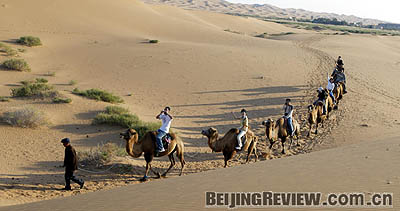|

The deserts in the Ningxia Hui Autonomous Region have been turned into grasslands and farmlands on which residents grow various fruits and plants to sell commercially. Wolfberries, Xisha watermelon (meaning sweet and rich in selenium), and fast-growing trees have become pillar products in some places in Ningxia's "desert industry."
Before it developed a desert economy, Ningxia was plagued by rapid desertification and huge amounts of nonarable lands that suffered from droughts and a lack of irrigation. More than half the region's 660,000 square km of land was once completely worthless, because the region is surrounded by three deserts-the Tengri Desert in the west, the Ulan Buh Desert in the north and the Mu Us Desert in the east. Residents who lived around the deserts racked their brains about how they could prevent the deserts from expanding.
According to the theory of desert industry, farmers should make full use of the abundant sunshine in the desert and the big temperature difference between day and night. Because China's western areas are mostly dry and lack water, developing a desert industry can be highly profitable for them.
Gold in desert
Ma Xinsheng, Deputy Director of the Gouqi Bureau in Zhongning County in the Ningxia Hui Autonomous Region, oversees the county's 11,000 hectares of wolfberry plantations. Gouqi is the Chinese name for wolfberries, highly nutritious red berries with superb antioxidant qualities, which have been used in traditional Chinese medicine for about 1,900 years. Wolfberries prefer dry weather and sandy soil and can endure high acidity levels.
"Ningxia's wolfberries are the best in China, while Zhongning's wolfberries are the best in Ningxia," Ma said. Besides Ningxia, wolfberries are also grown in west China's Xinjiang Uygur Autonomous Region.
The Zhongning wolfberry is an internationally recognized brand. The town has been accredited by the Chinese State Council as the hometown of the Chinese wolfberry.
Ma said Ningxia's history of growing wolfberries dates back 600 years, but they were not grown on large-scale plantations until the 1980s, after the locals learned more about the fruit's nutritional value. Wolfberry juice is sold in Europe and the United States, and the dried fruit is sold both domestically and internationally for about 40 yuan ($6) per kg, Ma said.
This year, Zhongning is growing 11,000 hectares of wolfberries, and each farmer is expected to earn 2,300 yuan ($336), Ma said. The income of the farmers is growing about 10 percent annually in Zhongning, despite price hikes in the country. But the rising costs of irrigation, electricity, fertilizer and labor have presented additional problems for wolfberry farmers. And competition is heating up as more farmers start to grow the fruit. Ma said the Gouqi Bureau is working on a program to absorb excess supplies of the berry.
Other treasures
Ningxia is also developing other commercially produced fruit in its deserts.
Its Xisha watermelons became famous overnight, after they were selected as the designated watermelon for guests at the Beijing Olympic Games in August.
Local people say Xisha watermelons grow out of "sand and stone." Ma Shangyi, a 67-year-old watermelon grower who lives in central Ningxia, told Beijing Review that the land he owns was once completely useless because of a lack of water and undesirable soil quality.
"Most of the time in the past, there was not enough food in my family, and we couldn't grow anything because the weather was too dry," Ma said.
The yearly rainfall in central Ningxia is less than 200 mm, but the annual evaporation rate is more than 20,000 mm. Because of this, part of the area was deemed "not suitable for human living" by the United Nations Development Program.
But the area and the prospects for its farmers changed after 2003. At that time, the local government paved the roads into rural villages like Ma's,
| 